The U.N.’s food arm said that famine is likely to spread across all regions of Somalia’s south in the next four to six weeks. Famine conditions are likely to persist until December, the Food and Agriculture Organization said.
Across Somalia, 3.7 million people are in crisis, the U.N. says, out of a population of 7.5 million. The U.N. says 3.2 million are in need of immediate, lifesaving assistance.
A malnourished child in a hospital in Mogadishu, Somalia, July 27, 2011. The al-Qaida-linked militant group al-Shabab, which controls much of southern Somalia, is blocking starving people from fleeing the country and setting up a cantonment camp where it is imprisoning displaced people who were trying to escape Shabab territory. (Tyler Hicks/The New York Times)
Kufow Ali Abdi carried the body of his 3-year-old daughter, Kadija, who had just died from measles at the hospital in Mogadishu, July 28, 2011. "I just hope they can save the others," he said, referring to his two remaining children, who were down to skin and bone. The al-Shabab Islamist insurgent group, which controls much of southern Somalia, is blocking starving people from fleeing the country and setting up a cantonment camp where it is imprisoning displaced people who were trying to escape al-Shabab territory. (Tyler Hicks/The New York Times)
A woman sits next to a child suffering from malnutrition at Banadir hospital in the Somali capital of Mogadishu, July 28, 2011. The al-Qaida-linked militant group al-Shabab, which controls much of southern Somalia, is blocking starving people from fleeing the country and setting up a cantonment camp where it is imprisoning displaced people who were trying to escape Shabab territory. (Tyler Hicks/The New York Times)
Flies cover the face of a boy suffering from malnutrition at a hospital in the Somali capital of Mogadishu, July 28, 2011. The al-Shabab Islamist insurgent group in Somalia is widely blamed for causing a famine by forcing out many Western aid organizations, depriving drought victims of desperately needed food and blocking starving people from fleeing territory controled by the group. The situation is growing bleaker by the day, with tens of thousands of Somalis already dead and more than 500,000 children on the brink of starvation. (Tyler Hicks/The New York Times)
A boy suffering from malnutrition has a scarf cover his face to keep the flies away at a hospital in the Somali capital of Mogadishu, July 28, 2011. (Tyler Hicks/The New York Times)
People displaced from their villages arriving in the Somali capital of Mogadishu, July 27, 2011. The al-Qaida-linked militant group al-Shabab, which controls much of southern Somalia, is blocking starving people from fleeing the country. (Tyler Hicks/The New York Times)
People at a makeshift camp in Mogadishu, Somalia. The al-Qaida-linked militant group al-Shabab, which controls much of southern Somalia, is blocking starving people from fleeing the country and setting up a cantonment camp where it is imprisoning displaced people who were trying to escape Shabab territory. (Tyler Hicks/The New York Times)
People who have fled their villages build a makeshift shelter after arriving in the Somali capital of Mogadishu, July 27, 2011. (Tyler Hicks/The New York Times)
A woman holds a malnourished child at a makeshift camp in the Somali capital of Mogadishu. The al-Qaida-linked militant group al-Shabab, which controls much of southern Somalia, is blocking starving people from fleeing the country. (Tyler Hicks/The New York Times)
Malnourished children in a hospital in Mogadishu, Somalia, July 27, 2011. (Tyler Hicks/The New York Times)
A child suffering from malnutrition is bathed at a hospital in the Somali capital of Mogadishu. The al-Qaida-linked militant group al-Shabab, which controls much of southern Somalia, is blocking starving people from fleeing the country and setting up a cantonment camp where it is imprisoning displaced people who were trying to escape Shabab territory. (Tyler Hicks/The New York Times)
A woman carries a child at a makeshift shelter in the Somali capital of Mogadishu, July 27, 2011. (Tyler Hicks/The New York Times)
A malnourished child in a hospital in Mogadishu. The al-Qaida-linked militant group al-Shabab, which controls much of southern Somalia, is blocking starving people from fleeing the country and setting up a cantonment camp. (Tyler Hicks/The New York Times)
Soldiers from the Somalian transitional government forces patrol the border town of Dhobley, Somalia, Sunday, July 24, 2011. Some thousands of people have arrived in Mogadishu seeking aid and The World Food Program executive director Josette Sheeran said Saturday they can't reach the estimated 2.2 million Somalis in desperate need of aid who are in militant-controlled areas of Somalia. (AP Photo/Schalk van Zuydam)
Somalis displaced by drought wait to receive food aid in Mogadishu, Somalia, Monday, July 25, 2011. Some thousands of people have arrived in Mogadishu seeking aid and The World Food Program executive director Josette Sheeran said Saturday they can't reach the estimated 2.2 million Somalis in desperate need of aid who are in militant-controlled areas of Somalia. (AP (AP Photo/Mohamed Sheikh Nor)
A general view of the Dadaab Refugee camp in eastern Kenya, where the influx of Somali's displaced by a ravaging famine remains high, on July 23, 2011. The European Union Aid Commissioner Kristalina Georgieva has vowed to do all that is possible to help 12 million people struggling from extreme drought across the Horn of Africa, boosting aid by $40 million. The funds come on top of almost $100 million the bloc has already contributed as assistance in the worst regional drought in decades, affecting parts of Ethiopia, Kenya, Somalia, Djibouti and Uganda. AFP PHOTO/Tony KARUMBA
A dust storm blows as newly arrived Somalian refugees settle on the edge of the Dagahaley refugee camp, which makes up part of the giant Dadaab refugee settlement on July 23, 2011 in Dadaab, Kenya. The refugee camp at Dadaab, located close to the Kenyan border with Somalia, was originally designed in the early 1990s to accommodate 90,000 people but the UN estimates over 4 times as many reside there. The ongoing civil war in Somalia and the worst drought to affect the Horn of Africa in six decades has resulted in an estimated 12 million people whose lives are threatened. (Photo by Oli Scarff/Getty Images)
A Somali refugee herds goats through the IFO refugee camp, which makes up part of the giant Dadaab refugee settlement on July 24, 2011 in Dadaab, Kenya. (Photo by Oli Scarff/Getty Images)
Warehouse attendant carry bags of goods donated during a funds drive by the Somali-community living in Kenya's capital, to aid Somali refugees in Kenya's north-easterly province at the Dadaab refugee complex, on July 29, 2011 in Nairobi. The African Union says on July 31 it will host a donors conference for Somali drought victims in Addis Ababa on August 9 as tens of thousands have died in recent months, according to the Food and Agricultural Organisation. Somalia is the worst-affected country, with some 1.25 million children in need of urgent life saving care, according to UNICEF. This month, the UN declared famine in two areas of the country, the first time famine has been announced this century. AFP PHOTO / Tony KARUMBA
Somalian refugees wait at the entrance to the registration area of the IFO refugee camp, which makes up part of the giant Dadaab refugee settlement on July 24, 2011 in Dadaab, Kenya. The refugee camp at Dadaab, located close to the Kenyan border with Somalia, was originally designed in the early 1990s to accommodate 90,000 people but the UN estimates over 4 times as many reside there. The ongoing civil war in Somalia and the worst drought to affect the Horn of Africa in six decades has resulted in an estimated 12 million people whose lives are threatened. (Photo by Oli Scarff/Getty Images)
A Somali refugee woman holding a bag of food aid walks past those waiting at the entrance to the registration area of the IFO refugee camp which makes up part of the giant Dadaab refugee settlement on July 24, 2011 in Dadaab, Kenya. (Photo by Oli Scarff/Getty Images)
Somali women and children wait for food to be distributed in the Doloow region, southern Somalia on July 24, 2011. The UN's World Programme Programme airlift of food for the Somali capital Mogadishu was delayed on on July 26, 2011 after efforts were hampered by last minute paperwork in Kenya. PETER MARTELL/AFP/Getty Images
Somalian refugees leave their hut on the outskirts of the Dagahaley refugee camp, which makes up part of the giant Dadaab refugee settlement on July 23, 2011 in Dadaab, Kenya. The refugee camp at Dadaab, located close to the Kenyan border with Somalia, was originally designed in the early 1990s to accommodate 90,000 people but the UN estimates over 4 times as many reside there. (Photo by Oli Scarff/Getty Images)
A Somalian refugee digs a latrine on the outskirts of the IFO refugee camp which makes up part of the giant Dadaab refugee settlement in Dadaab, Kenya. (Photo by Oli Scarff/Getty Images)
An elederly woman sits as she waits for food ratios at a feeding center in Lolkuta, near Wajir on July 21, 2011. The UN's World Programme Programme was preparing on July 26, 2011 to airlift food aid into the Somali capital Mogadishu, but efforts were hampered by last minute paperwork in Kenya. An estimated 3.7 million people in Somalia -- around a third of the population -- are on the brink of starvation and millions more in Djibouti, Ethiopia, Kenya and Uganda have been struck by the worst drought in the region in 60 years. SIMON MAINA/AFP/Getty Images
A Somali refugee rests on a wheelbarrow at the entrance to the registration area of the IFO refugee camp which makes up part of the giant Dadaab refugee settlement in Dadaab, Kenya. (Photo by Oli Scarff/Getty Images)
A young boy from southern Somalia takes cover under a plastic sheet in a refugee camp in Mogadishu, Somalia, Sunday, July 31, 2011. Tens of thousands of famine-stricken Somali refugees were cold and drenched after torrential rains overnight pounded their makeshift structures in the capital, Mogadishu. Rains are needed to plant crops and alleviate the drought that is causing famine in Somalia but on Saturday night the rains added to the misery of refugees who live in structures made of sticks and pieces of cloth. (AP Photo/Farah Abdi Warsameh)
A doctor examines Mihag Gedi Farah, a seven- month-old child with a weight of 7.5 lbs., in a field hospital of the International Rescue Committee, IRC, in the town of Dadaab, Kenya. The U.N. will airlift emergency rations this week to parts of drought-ravaged Somalia that militants banned it from more than two years ago in a crisis intervention to keep hungry refugees from dying along what an official calls the "roads of death." Tens of thousands already have trekked to neighboring Kenya and Ethiopia, hoping to get aid in refugee camps. (AP Photo/Schalk van Zuydam)
A malnourished mentally disabled refugee from Somalia is tied down to prevent him falling out of his bed at a hospital of the International Rescue Committee, IRC, in Dadaab, Kenya, Wednesday, Aug 3, 2011. Dadaab, a camp designed for 90,000 people now houses around 440,000 refugees. Almost all are from war-ravaged Somalia. Some have been here for more than 20 years, when the country first collapsed into anarchy. But now more than 1,000 are arriving daily, fleeing fighting or hunger.(AP Photo/Schalk van Zuydam)
A malnourished refugee from Somalia has a blood sample taken by a doctor at a field hospital of the International Rescue Committee, IRC, in Dadaab, Kenya. (AP Photo/Schalk van Zuydam)
Khalif Yussuf tries to fall asleep at a field hospital of the International Rescue Committee, IRC, in Dadaab, Kenya, Monday, Aug 1, 2011. Dadaab, a camp designed for 90,000 people now houses around 440,000 refugees. Almost all are from war-ravaged Somalia. Some have been here for more than 20 years, when the country first collapsed into anarchy. But now more than 1,000 are arriving daily, fleeing fighting or hunger.(AP Photo/Schalk van Zuydam)
Newly arrived Somali refugees wait for medical examinations for their children at a centre at the Dadaab Refugee camp in eastern Kenya, where the influx of Somali's displaced by a ravaging famine remains high. TONY KARUMBA/AFP/Getty Images







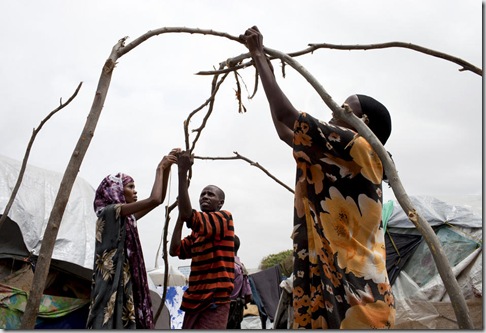







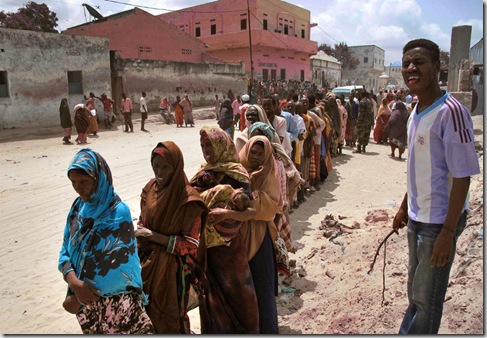






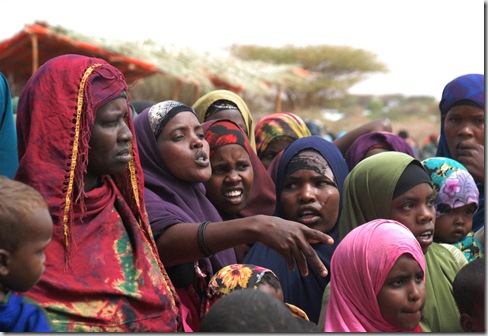

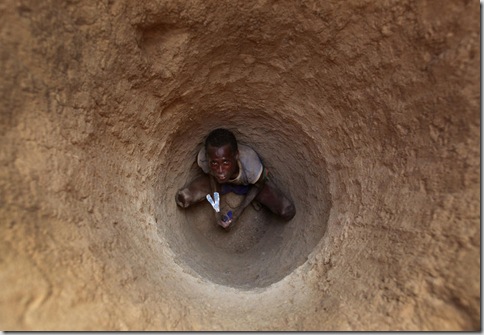
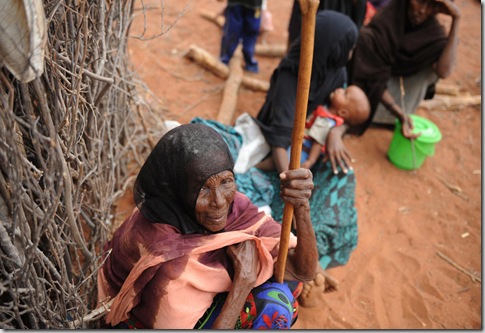
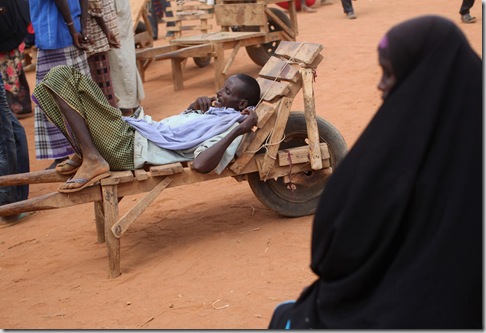






Nessun commento:
Posta un commento